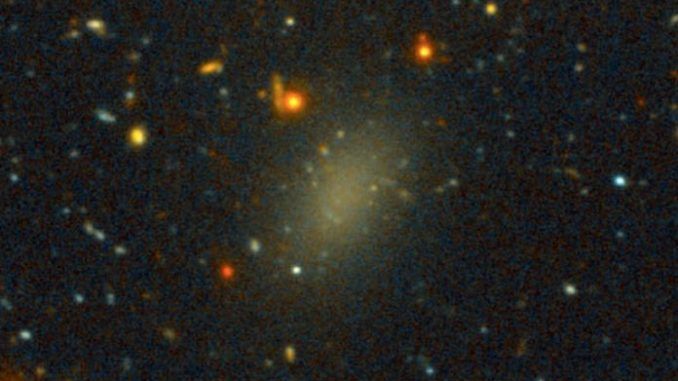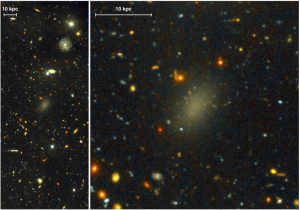
Astronomers using the world’s most powerful telescopes have discovered a massive galaxy made up almost entirely of dark matter.
Dragonfly 44 is located 300 million light-years away in the constellation Coma.
 Wired reports:
Wired reports:
Dark matter is the invisible ‘gravitational glue’ that holds galaxies together and is thought to make up five sixths of the universe’s mass.

BYPASS THE CENSORS
Sign up to get unfiltered news delivered straight to your inbox.
You can unsubscribe any time. By subscribing you agree to our Terms of Use
The galaxy, named Dragonfly 44, is roughly the same mass as the Milky Way, but our galaxy has a hundred times more stars.
Despite being relatively nearby Earth, the intriguing galaxy has evaded the attention of astronomers for decades because it is very dim.
However, an international team of astronomers spotted it last year using the WM Keck Observatory and the Gemini North Telescope in Manuakea, Hawaii, when the Dragonfly Telephoto Array observed a region of the sky in the constellation Coma.
They realised the galaxy had to have more than meets the eye; it has so few stars that it quickly would be ripped apart unless something was holding it together – dark matter.
To determine the amount of dark matter in Dragonfly 44, astronomers used the DEIMOS instrument installed on Keck II to measure the velocities of stars for 33.5 hours over a period of six nights so they could determine the galaxy’s mass.
The team then used the Gemini Multi-Object Spectrometer (GMOS) on the eight-metre Gemini North telescope to reveal a halo of spherical clusters of stars around the galaxy’s core, similar to the halo that surrounds our Milky Way galaxy.
“Motions of the stars tell you how much matter there is, van Pieter van Dokkum of Yale University explained. They don’t care what form the matter is, they just tell you that it’s there.
“In the Dragonfly galaxy stars move very fast. So there was a huge discrepancy: using Keck Observatory, we found many times more mass indicated by the motions of the stars, than there is mass in the stars themselves.”
The mass of the Dragonfly 44 galaxy is estimated to be a trillion times the mass of the sun, which is very similar to the mass of our own Milky Way galaxy.
However, only one hundredth of one per cent of that is in the form of stars and “normal” matter. The other 99.99 per cent is in the form of dark matter, making it dramatically different.
The Milky Way has more than a hundred times more stars than Dragonfly 44, which is described in the study published The Astrophysical Journal Letters.
Speaking about “fluffiest galaxies” last year, of which Dragonfly 44 is one, Dr van Dokkum said: “If t If the Milky Way is a sea of stars, then these newly discovered galaxies are like wisps of clouds.
“They are found in a dense, violent region of space filled with dark matter and galaxies whizzing around, so we think they must be cloaked in their own invisible dark matter ‘shields’ that are protecting them from this intergalactic assault.”
Finding a galaxy with the mass of the Milky Way that is almost entirely dark was unexpected. Roberto Abraham, Professor of Astronomy at the University of Toronto and a co-author of the study said: “We have no idea how galaxies like Dragonfly 44 could have formed.
“The Gemini data show that a relatively large fraction of the stars is in the form of very compact clusters, and that is probably an important clue. But at the moment we’re just guessing.”
Dr van Dokkkum added: “This has big implications for the study of dark matter. It helps to have objects that are almost entirely made of dark matter so we don’t get confused by stars and all the other things that galaxies have.
“The only such galaxies we had to study before were tiny. This finding opens up a whole new class of massive objects that we can study.”
He continued: “Ultimately what we really want to learn is what dark matter is. The race is on to find massive dark galaxies that are even closer to us than Dragonfly 44, so we can look for feeble signals that may reveal a dark matter particle.”


